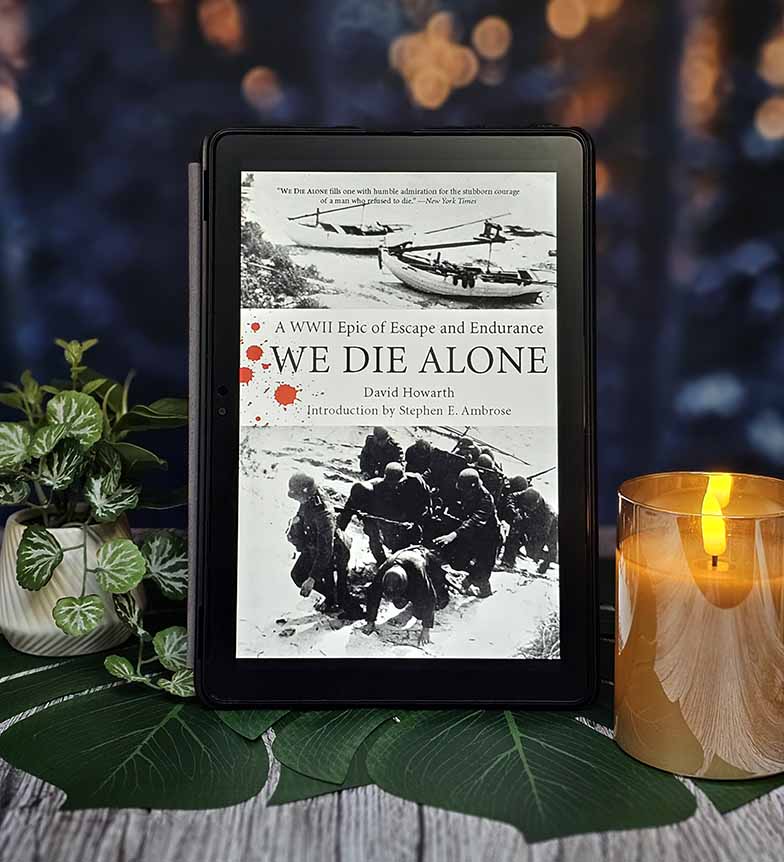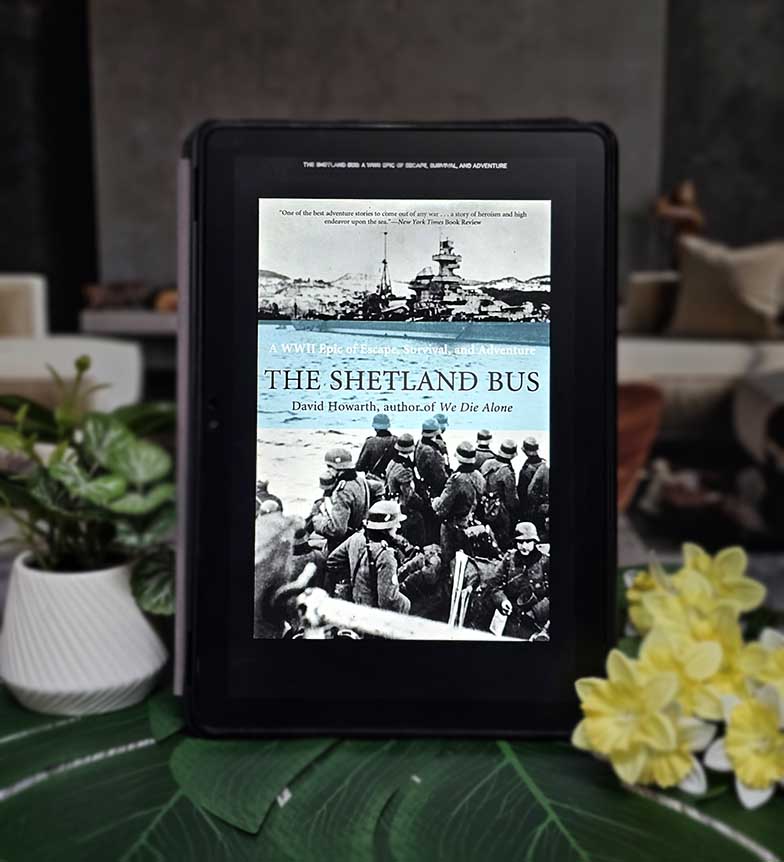
We Die Alone
by David Howarth
The extraordinary true story of Jan Baalsrud, a Norwegian commando who survived alone in the Arctic wilderness for months after a failed sabotage mission during World War II.
Spoiler Warning
This review may contain spoilers. Read at your own discretion if you haven't finished the book yet.
Survival Against All Odds: The Extraordinary True Story of Human Endurance and Courage
We Die Alone stands as one of the most compelling survival stories ever documented, transforming Jan Baalsrud's incredible World War II ordeal into a masterpiece of narrative non-fiction that explores the absolute limits of human endurance and the moral courage of ordinary people under extraordinary circumstances. David Howarth's meticulous research and compelling storytelling create a work that functions simultaneously as thrilling adventure story, historical document, and profound meditation on what human beings are capable of when survival demands the impossible.
The Mission and Its Catastrophic Beginning
Operation Martin: Sabotage Gone Wrong
The story begins with a covert Norwegian commando operation designed to disrupt German supply lines in occupied Norway. When the mission is betrayed and Baalsrud's team is captured or killed, he becomes the sole survivor of a carefully planned military operation, suddenly alone in hostile territory with Nazi forces actively hunting him.
This initial disaster sets up the central tension that drives the entire narrative—one man's attempt to survive in conditions that would normally prove fatal, while avoiding capture by an enemy determined to find him.
The Escape: From Military Mission to Survival Ordeal
Baalsrud's escape from the German ambush transforms him from trained commando executing a military mission into desperate survivor relying entirely on instinct, determination, and the kindness of strangers. This transition from organized resistance to individual survival creates the framework for examining different forms of courage and endurance.
The Arctic Wilderness: Nature as Character
The Norwegian Landscape as Ally and Enemy
The harsh Arctic environment serves as both protective cover from German forces and constant threat to Baalsrud's survival. Howarth's descriptions of the landscape create vivid sense of a world where beauty and danger are inseparable, where the same snowstorm that hides a fugitive can also kill him.
The detailed portrayal of Arctic conditions—extreme cold, blizzards, avalanches, and the disorienting effects of constant daylight or darkness—makes the environment feel like an active character in the story rather than passive backdrop.
Survival Skills and Improvisation
The book documents Baalsrud's gradual adaptation to wilderness survival, from his initial military training to the desperate improvisations required for long-term survival in conditions no training could fully prepare him for.
His self-amputation of gangrenous toes, construction of snow shelters, and methods for finding food and water demonstrate the remarkable human capacity for adaptation when death is the alternative to innovation.
The Network of Resistance: Ordinary Heroes
Civilian Courage Under Occupation
The most profound aspect of the story may be the network of ordinary Norwegians who risked their lives to help a stranger. Farmers, fishermen, teachers, and families made split-second decisions to provide assistance knowing that discovery meant death not just for themselves but for their loved ones.
These acts of compassion under extreme danger illuminate the moral complexity of life under occupation, where every interaction with resistance fighters puts civilian populations at risk while refusing help means abandoning fundamental human decency.
The Sami People: Cultural Resistance and Survival Expertise
The Sami reindeer herders who ultimately help transport Baalsrud to safety represent both cultural resistance to occupation and indigenous survival knowledge that proves crucial to his rescue. Their involvement adds layers of cultural and historical complexity to the survival narrative.
Their traditional knowledge of Arctic travel and survival techniques, combined with their own reasons for resisting German occupation, creates a compelling subplot about how different communities contributed to resistance efforts.
Physical and Psychological Endurance
The Limits of Human Survival
Baalsrud's physical ordeal—including severe frostbite, snow blindness, malnutrition, and infected wounds—pushes human endurance to its absolute limits. Howarth's clinical descriptions of these conditions create visceral understanding of what survival actually costs.
The progression of his physical deterioration and gradual adaptation to extreme conditions provides compelling study of human resilience and the body's capacity to continue functioning under circumstances that should prove fatal.
Mental Fortitude and Psychological Survival
Perhaps even more remarkable than Baalsrud's physical survival is his maintenance of mental clarity and determination throughout months of isolation, pain, and constant danger. The book explores how psychological resilience enables physical survival when circumstances become seemingly impossible.
His ability to maintain hope, make rational decisions under extreme stress, and retain enough humanity to trust the strangers who offered help demonstrates the psychological dimensions of survival that complement physical endurance.
Historical Context and Significance
Norwegian Resistance During World War II
The story illuminates the broader context of Norwegian resistance to German occupation, showing how military operations, civilian assistance networks, and individual acts of courage combined to create effective opposition to Nazi control.
The book provides insight into how resistance movements actually functioned on the ground level, where success depended not just on military training but on the willingness of ordinary people to take extraordinary risks.
Occupation Psychology and Collaboration
Through the various Norwegian characters who help or threaten Baalsrud, Howarth explores the complex psychology of life under occupation, where collaboration and resistance exist on a spectrum rather than as absolute categories.
The moral complexity of these choices adds depth to what could have been a simple adventure story, showing how war forces impossible decisions on people who never expected to face such circumstances.
Narrative Technique and Storytelling
Reconstruction of Events
Howarth's challenge was reconstructing events from interviews with survivors, many of whom had reasons to be cautious about revealing their wartime activities. His method of verification and narrative construction creates compelling story while maintaining historical accuracy.
The author's ability to transform documentary evidence into vivid narrative demonstrates masterful approach to non-fiction storytelling that respects both factual accuracy and reader engagement.
Pacing and Tension
Despite knowing that Baalsrud survived (since he was interviewed for the book), Howarth maintains constant tension through detailed descriptions of near-disasters, close calls with German forces, and the ongoing deterioration of the protagonist's physical condition.
The pacing alternates between moments of extreme danger and periods of slow recovery, creating rhythm that mirrors the actual experience of survival under these conditions.
Themes of Courage and Sacrifice
Different Forms of Heroism
The book presents multiple definitions of heroism—from Baalsrud's physical endurance to the quiet courage of civilians who provided assistance despite enormous personal risk. This multifaceted approach to courage avoids simple heroic narratives in favor of more complex understanding of moral behavior under pressure.
The Cost of Resistance
Rather than romanticizing resistance activities, Howarth honestly portrays the enormous personal costs—physical, psychological, and social—that resistance imposed on everyone involved, from trained commandos to civilian helpers.
Contemporary Relevance
Refugee and Survival Narratives
Baalsrud's experience as someone dependent entirely on the kindness of strangers resonates with contemporary refugee experiences and discussions about moral obligations to help people in desperate circumstances.
Physical and Mental Resilience
The story provides insight into human capacity for endurance that feels relevant to contemporary discussions about mental health, trauma recovery, and the relationship between physical and psychological well-being.
Moral Courage in Difficult Times
The civilian helpers' willingness to risk everything for moral principles speaks to contemporary questions about when and how individuals should take personal risks to oppose injustice or help others.
Literary Merit and Impact
Historical Documentation
The book serves as valuable historical document that preserves firsthand accounts of resistance activities and survival techniques while making this history accessible to general readers.
Adventure Narrative Excellence
As pure adventure story, the book succeeds in creating compelling narrative that maintains reader engagement while respecting the gravity of its subject matter and the reality of human suffering.
Psychological Insight
The exploration of how people behave under extreme stress provides lasting insight into human nature that transcends the specific historical circumstances.
Target Audience and Appeal
History Enthusiasts
Readers interested in World War II history, resistance movements, and Norwegian culture will find detailed, well-researched account that brings historical events to vivid life.
Adventure and Survival Readers
Those drawn to survival stories will encounter one of the most extreme and well-documented survival ordeals ever recorded, with authentic detail that fictional adventures cannot match.
Students of Human Nature
The book appeals to readers interested in psychology, ethics, and human behavior under extreme circumstances, providing real-world case study of courage, endurance, and moral choice.
Final Assessment
We Die Alone succeeds as both thrilling survival narrative and profound exploration of human courage under the most extreme circumstances imaginable. Howarth has created a work that honors the extraordinary bravery of all involved—both the man who survived the impossible and the people who risked everything to help him—while providing lasting insight into the capacity for good that emerges even in the darkest historical moments.
The book's greatest achievement is its demonstration that the most remarkable human stories are often true ones, and that ordinary people are capable of extraordinary courage when circumstances demand it. This is essential reading for anyone seeking to understand what human beings are capable of when survival, morality, and decency are all at stake simultaneously.
The story serves as both historical record and timeless testament to the power of individual courage and community compassion to triumph over organized evil and natural forces that seem insurmountable.
Rating: 5.0/5 ⭐
Perfect for: History enthusiasts, survival story fans, readers interested in World War II resistance movements, anyone seeking inspiration about human resilience
Consider carefully if: Detailed descriptions of survival ordeals or wartime violence are difficult for you
My Notes & Takeaways
Key Themes and Moments
Human Endurance Beyond Limits: "The human body and spirit can endure far beyond what seems possible when survival is the only alternative to death."
Baalsrud's survival—including self-amputation of frostbitten toes and months of hiding in snow caves—demonstrates the extraordinary resilience of human beings under extreme conditions.
The Power of Community Resistance: "In occupied Norway, ordinary people became heroes not through grand gestures but through quiet acts of courage that risked everything."
The network of civilians who helped Baalsrud survive shows how resistance movements depend on countless individual acts of bravery by people who could have chosen safety instead.
Moral Courage Under Occupation: "When helping a stranger means risking your family's life, every act of assistance becomes a profound moral choice."
The book explores how occupied populations navigate impossible ethical decisions where compassion and self-preservation conflict.
Nature as Both Enemy and Ally: The Arctic landscape serves simultaneously as protective shelter from Nazi forces and deadly threat to human survival, creating constant tension between seeking help and avoiding capture.
You Might Also Like

The Shetland Bus
by David Howarth
The true story of the secret World War II operations between Shetland and Norway. A gripping account of courage, danger, and resistance during the Nazi occupation.

In the Shadow of the Valley
by Bobi Conn
A powerful memoir of growing up in rural Appalachian Kentucky, surviving abuse and poverty, and ultimately finding a path to healing and education. A raw and unflinching look at the cycles of poverty and violence in forgotten America.

The Impossible Climb
by Mark Synnott
The riveting story of Alex Honnold's historic free solo climb of El Capitan's 3,000-foot Dawn Wall, and the obsessive pursuit of perfection in one of the most dangerous athletic achievements ever attempted.